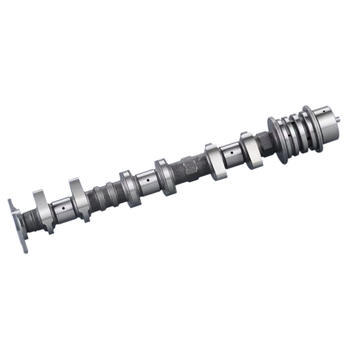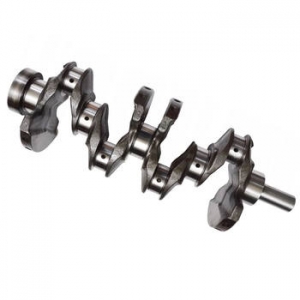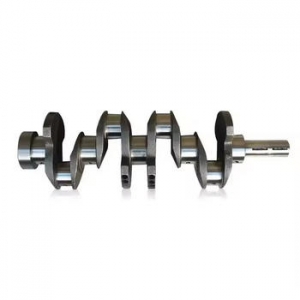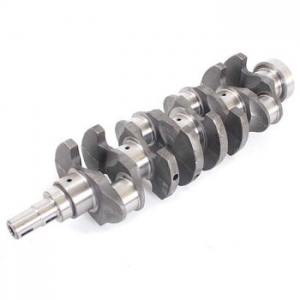Frankly speaking, when you think about the heart of a Perkins engine, several components might come to mind: the pistons, the cylinder block, perhaps even the fuel injection system. But arguably the most vital, the one that truly makes the engine run by converting explosive power into rotational energy, is the Perkins crankshaft. This complex piece of engineering is subjected to immense forces, high temperatures, and constant friction, yet it's expected to perform flawlessly for thousands upon thousands of hours. Its integrity is absolutely fundamental to the engine's performance, longevity, and overall reliability. Understanding the importance and nuances of the crankshaft is key for anyone who operates, maintains, or repairs Perkins engines, whether they are used in industrial machinery, agricultural equipment, or power generation applications. It's not just a metal shaft; it's a precision component designed to withstand incredible stress while maintaining precise balance and alignment, enabling everything else in the engine to function in harmony. Have you ever stopped to consider just how much work this single component does under the hood?
The Perkins crankshaft is a marvel of mechanical engineering, meticulously designed to handle the relentless up-and-down motion of the pistons and transform it into the smooth, continuous rotation that powers equipment. Each throw on the crankshaft corresponds to a piston, and as combustion forces the piston downwards, the connecting rod pushes on the crankpin, causing the shaft to turn. This process repeats thousands of times per minute at operational speeds. The precision involved in manufacturing is astonishing; dimensions, balance, and surface finish must be held to incredibly tight tolerances. Even minor imperfections can lead to vibration, premature wear, or catastrophic failure. Interestingly enough, the design varies significantly depending on the specific Perkins engine series and its intended application, but the core principle remains the same: reliable conversion of linear force to rotational torque. The material used is typically high-strength forged steel, chosen for its durability and ability to withstand extreme stress cycles. The journals, which are the surfaces that ride in the main bearings and connecting rod bearings, are hardened and polished to a mirror finish to minimize friction and wear. The balance weights are strategically placed to counteract the inertial forces of the rotating and reciprocating masses, ensuring smooth operation and reducing stress on the engine block and bearings. It's a component that truly embodies the phrase "strength and precision."
The Critical Function and Design of the Perkins Crankshaft
Delving deeper into the role of the Perkins engine crankshaft reveals just how fundamental it is. It acts as the central spine of the reciprocating engine, connecting the pistons to the flywheel and ultimately to the transmission or driven equipment. Without a robust and properly functioning crankshaft, the energy generated by combustion would remain confined within the cylinders. The design parameters are incredibly stringent, taking into account factors like engine displacement, power output, operating speed range, and expected load cycles. Forging is a common manufacturing method, shaping the steel through intense heat and pressure to align the grain structure for maximum strength. Following forging, extensive machining is required to create the main journals and crankpins, drill oil passages, and machine surfaces for balance weights. Precision grinding and polishing of the bearing surfaces are final steps to ensure minimal friction and long bearing life. The internal oil passages are vital, allowing lubricating oil to flow from the main bearings to the connecting rod bearings under pressure, cooling and lubricating these high-stress points. Any blockage or restriction in these passages can lead to rapid bearing failure and subsequent damage to the crankshaft itself. Frankly speaking, the complexity hidden within this seemingly simple rotating shaft is quite remarkable.
Design Variations and Material Excellence in Crankshafts
It's worth noting that not all crankshaft Perkins engines use are identical. While the core function is the same, variations exist across different engine families and power ratings. For instance, a crankshaft for a small 3-cylinder Perkins engine will differ significantly in size, weight, and possibly even forging technique from one designed for a large 6-cylinder turbocharged industrial unit. These differences are deliberate, optimized for the specific forces and operating conditions each engine type will encounter. Material science plays a crucial role here; while forged steel is standard, the specific alloy composition, heat treatment processes, and surface hardening techniques (like induction hardening or nitriding) are carefully selected to provide the required strength, fatigue resistance, and wear properties. Some high-performance or heavy-duty applications might even utilize alternative materials or more advanced manufacturing processes. The balance of the crankshaft is also critical and involves adding or removing material from the balance weights during manufacturing. This ensures the shaft rotates smoothly, minimizing vibration that could otherwise cause excessive wear on bearings, seals, and even damage the engine block over time. Proper balancing is not just a manufacturing step; it's an ongoing concern, especially if a crankshaft requires regrinding during an overhaul, as the regrinding process can alter the balance.
Identifying Common Issues with Perkins Crankshafts
Despite their robust construction, Perkins crankshafts are not immune to wear and potential issues over time. Given the tremendous loads they bear and the high speeds at which they operate, specific problems can arise, particularly if maintenance schedules are neglected or if the engine is subjected to abnormal operating conditions. One of the most common issues is wear on the main and connecting rod journals. This wear can be caused by inadequate lubrication (low oil pressure, wrong oil type, contaminated oil), abrasive particles in the oil, or simply exceeding the component's designed lifespan. Journal wear manifests as a loss of material, leading to increased bearing clearances. This excessive clearance causes knocking sounds, reduced oil pressure at the bearings, and eventually can lead to bearing failure and potentially seizing the crankshaft within the engine block. Another significant issue is cracking. Cracks typically originate from stress risers, such as sharp corners, manufacturing defects, or points subjected to excessive fatigue stress. Severe engine knocks, hydrostatic lock (where liquid enters the cylinder), or excessive vibration can accelerate crack formation. Warping or bending of the crankshaft is less common but can occur if the engine experiences severe overheating or a catastrophic failure like a thrown connecting rod. Recognizing the signs of these problems early is crucial for preventing more extensive and costly damage to the entire engine.
Signs of Wear and Potential Failure in Your Crankshaft
Knowing what to look and listen for can save an engine from total destruction. Symptoms of a failing crankshaft for Perkins engines often include a distinct knocking sound that changes with engine speed and load – this is often due to excessive bearing clearance. Low oil pressure, especially at operating temperature, can also be an indicator, as worn bearings allow oil to leak out too quickly, reducing pressure throughout the system. Metal particles in the engine oil, particularly bearing material, are a clear warning sign of severe wear. Vibration that seems excessive or unusual can also point to crankshaft issues, potentially related to balance problems or bending. During an engine overhaul, a thorough visual inspection and dimensional measurement of the crankshaft journals are mandatory. Micrometers are used to check the diameter of each journal in multiple spots, looking for ovality or taper, which indicate uneven wear. Magnetic particle inspection or dye penetrant testing can reveal surface cracks that are not visible to the naked eye. Plastigauge is used to measure bearing clearances accurately during assembly. Ignoring early warning signs or attempting to run an engine with a known crankshaft issue is incredibly risky and almost always leads to more severe failure. It's a situation where proactive inspection and maintenance truly pay off.
Maintaining and Inspecting Your Perkins Crankshaft
Proper maintenance is the cornerstone of ensuring a long and reliable life for your Perkins crankshaft. The most critical aspect of maintenance is diligent engine oil management. Using the correct type and viscosity of oil specified by Perkins, adhering strictly to recommended oil and filter change intervals, and ensuring the engine always operates with sufficient oil pressure are paramount. Clean oil is vital because contaminants, especially abrasive particles, are a major cause of journal and bearing wear. The oil filter's job is to capture these particles, so using high-quality filters and changing them regularly is just as important as changing the oil itself. Beyond routine fluid changes, periodic inspections during engine servicing or overhauls are necessary. When the oil pan is removed, visual inspection of the crankshaft and lower bearings can provide clues about their condition. Checking for metal debris in the pan is essential. If the engine is being significantly disassembled, the crankshaft should be removed and thoroughly inspected. This involves cleaning it thoroughly, performing visual checks for cracks or damage, and precisely measuring the journals for wear, ovality, and taper using specialized tools. Comparing these measurements to Perkins' specifications will determine if the crankshaft is still within usable limits, requires regrinding, or needs replacement. Neglecting these steps is, frankly speaking, a gamble you don't want to take with a critical component like this.
Best Practices for Crankshaft Care and Assessment
Implementing best practices for Perkins engine crankshaft care goes beyond just oil changes. It includes monitoring engine operating conditions – avoiding prolonged operation at excessively high or low speeds under heavy load, preventing engine overheating, and addressing any signs of knocking or unusual vibration promptly. When an engine is being rebuilt, the crankshaft must be cleaned meticulously, ensuring all oil passages are clear. Air pressure or special brushes can be used to remove debris. Before reinstallation, it's crucial to ensure the crankshaft is free of any nicks or burrs that could damage the new bearings. If the journals show wear but are still within limits for regrinding, this is a viable option. Regrinding involves machining the journals down to a smaller, specified undersize diameter and then polishing them to the correct surface finish. This requires specialized machinery and expertise to maintain straightness, concentricity, and balance. After regrinding, the correct undersize bearings must be used. However, a crankshaft can only be reground a limited number of times before it becomes too weak or reaches its maximum allowable undersize. At that point, replacement becomes necessary. Knowing the history of a crankshaft and its previous regrinds is vital when considering reuse during an overhaul. Many experts agree that when in doubt about the condition or history, replacing the crankshaft is often the most reliable path during a major engine rebuild, ensuring the foundation is solid.
Choosing the Right Replacement Perkins Crankshaft
When inspection reveals that a Perkins crankshaft is worn beyond acceptable limits, cracked, or damaged, replacement is the only viable option to restore engine integrity and performance. This brings up a crucial decision: choosing the right replacement part. Generally, you have two primary options: a genuine Perkins crankshaft (often referred to as OEM - Original Equipment Manufacturer) or an aftermarket crankshaft. Genuine Perkins crankshafts are manufactured to the exact specifications, materials, and quality control standards set by Perkins themselves. They are designed to be a direct fit and are guaranteed to perform as the original part intended. While typically more expensive upfront, they offer peace of mind regarding quality, compatibility, and durability. Aftermarket crankshafts, on the other hand, are produced by independent manufacturers. The quality of aftermarket parts can vary significantly. Some aftermarket suppliers produce parts that meet or even exceed OEM specifications, offering a reliable and potentially more cost-effective alternative. Others may use inferior materials, less precise manufacturing processes, or have inadequate quality control, leading to premature wear, poor performance, or even early failure. It's essential to research the reputation of the aftermarket supplier and ensure their products meet industry standards and are specifically designed for your Perkins engine model. Price should not be the only determining factor when selecting a replacement crankshaft.
Evaluating Options: Genuine vs. Aftermarket Crankshafts
Deciding between a genuine Perkins crankshaft and a high-quality aftermarket one requires careful consideration. For critical applications where downtime is extremely costly or engine reliability is absolutely paramount, many operators and mechanics prefer the assurance that comes with a genuine OEM part. You know exactly what you're getting, backed by the manufacturer's warranty and reputation. However, for budget-conscious repairs or in less demanding applications, a reputable aftermarket crankshaft can be a perfectly acceptable and economical choice. The key word here is "reputable." How do you assess the quality of an aftermarket supplier? Look for suppliers with a long history in the industry, positive customer reviews, and certifications (such as ISO 9001) that indicate a commitment to quality management. Ask about the materials used, the manufacturing processes (are they forged or cast? what heat treatment is applied?), and their quality control procedures (do they perform non-destructive testing like magnetic particle inspection?). A good supplier will be transparent about their processes and specifications. I've found that building a relationship with trusted parts suppliers who specialize in engines like Perkins is invaluable. They often have the expertise to guide you towards reliable options, whether genuine or high-quality aftermarket. Ultimately, the goal is to install a crankshaft that will provide reliable service for the expected lifespan of the engine repair or rebuild, avoiding the costly consequences of premature failure.
Ensuring Quality and Longevity in Your Perkins Crankshaft
Ensuring the quality and maximizing the longevity of a crankshaft for Perkins engines involves a holistic approach, encompassing proper part selection, correct installation, and diligent ongoing maintenance. As discussed, sourcing a quality replacement, whether genuine or from a trusted aftermarket supplier, is the first step. Once you have the correct part, installation must be performed by trained technicians following Perkins' detailed service manuals. This includes proper cleaning of the engine block's main bearing saddles, correct torqueing procedures for the main bearing caps, using the specified bearing clearances (checked with Plastigauge), and ensuring correct end play (axial clearance) of the crankshaft. Incorrect installation, particularly improper torqueing of main caps or insufficient lubrication during assembly, can lead to immediate or rapid failure of new bearings and damage to the crankshaft journals. But installation is just the beginning. The engine's long-term health depends on consistent maintenance. This loops back to the critical importance of clean, correct-type oil, timely filter changes, and maintaining proper operating temperatures and pressures. Regular monitoring of engine sounds, oil pressure, and temperature can provide early warnings of potential issues before they become catastrophic. Think of the crankshaft as the foundation of your engine's rotating assembly; its health is paramount. Cutting corners on quality during replacement or skimping on maintenance will almost inevitably lead to significant problems down the line, proving that investing in quality and care upfront is always the wiser decision.
The Ripple Effect of Crankshaft Quality on Engine Performance
The quality of the Perkins crankshaft doesn't just affect its own lifespan or the bearings; it has a ripple effect throughout the entire engine. A properly manufactured and balanced crankshaft contributes to smoother engine operation, reducing vibration that can stress other components like seals, gaskets, engine mounts, and even accessory drives. Precision-machined journals ensure consistent oil film thickness, minimizing friction and heat generation at the bearings, which in turn contributes to better overall engine efficiency and reduced wear on other parts. Conversely, a low-quality or worn crankshaft can introduce excessive vibration, accelerate wear on bearings and other components, lead to oil pressure problems, and ultimately compromise engine performance and fuel efficiency. In extreme cases, crankshaft failure can cause severe internal engine damage, requiring a complete replacement or extensive repairs to the block, connecting rods, and pistons. Therefore, understanding the importance of crankshaft quality and investing in either genuine parts or thoroughly vetted aftermarket alternatives is not just about the crankshaft itself, but about protecting your entire engine investment. It's a prime example of how a single critical component's integrity dictates the performance and lifespan of the whole system. Are you confident in the quality of the crankshaft currently powering your Perkins engine?
In conclusion, the Perkins crankshaft stands as an undisputed cornerstone of the engine's mechanical function. Its demanding role in converting linear piston motion into usable rotational power necessitates exceptional design, materials, and manufacturing precision. While built for resilience, it is susceptible to wear and damage, primarily stemming from lubrication issues or operational stresses. Recognizing the early signs of wear, such as knocking sounds or low oil pressure, is critical for timely intervention. Proactive maintenance, centered around stringent oil management and periodic inspections, significantly extends the crankshaft's life. When replacement is necessary, the choice between a genuine Perkins part and a high-quality aftermarket option requires careful consideration, prioritizing proven quality and reliability over just cost. Ensuring proper installation and continuing diligent maintenance after replacement solidify the engine's foundation for reliable performance. Ultimately, the health of the crankshaft is inseparable from the overall health and longevity of the Perkins engine it serves. Our company understands the critical nature of this component and the need for reliable parts to keep your Perkins engines running efficiently and effectively.
For more detailed information, please visit our official website: Perkins crankshaft





